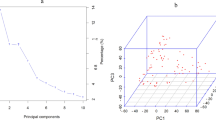Abstract
Characterization of the determinants of economically important phenotypes showing complex inheritance should lead to the more effective use of genetic resources. This study was conducted to determine the number, genome location and effects of QTLs determining malting quality in the two North American barley quality standards. Using a doubled-haploid population of 140 lines from the cross of Harrington×Morex, malting quality phenotype data sets from eight environments, and a 107-marker linkage map, QTL analyses were performed using simple interval mapping and simplified composite interval mapping procedures. Seventeen QTLs were associated with seven grain and malting quality traits (percentage of plump kernels, test weight, grain protein percentage, soluble/total protein ratio, α-amylase activity, diastatic power and malt-extract percentage). QTLs for multiple traits were coincident. The loci controlling inflorescence type [vrs1 on chromosome 2(2H) and int-c on chromosome 4(4H)] were coincident with QTLs affecting all traits except malt-extract percentage. The largest effect QTLs, for the percentage of plump kernels, test weight protein percentage, S/T ratio and diastatic power, were coincident with the vrs1 locus. QTL analyses were conducted separately for each sub-population (six-rowed and two-rowed). Eleven new QTLs were detected in the subpopulations. There were significant interactions between the vrs1 and int-c loci for grain-protein percentage and S/T protein ratio. Results suggest that this mating of two different germplasm groups caused a disruption of the balance of traits. Information on the number, position and effects of QTLs determining components of malting quality may be useful for maintaining specific allele configurations that determine target quality profiles.
Similar content being viewed by others
Author information
Authors and Affiliations
Additional information
Received: 28 May 1999 / Accepted: 9 November 1999
Rights and permissions
About this article
Cite this article
Marquez-Cedillo, L., Hayes, P., Jones, B. et al. QTL analysis of malting quality in barley based on the doubled-haploid progeny of two elite North American varieties representing different germplasm groups. Theor Appl Genet 101, 173–184 (2000). https://doi.org/10.1007/s001220051466
Issue Date:
DOI: https://doi.org/10.1007/s001220051466




